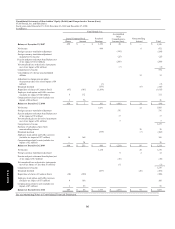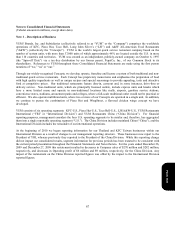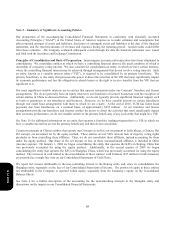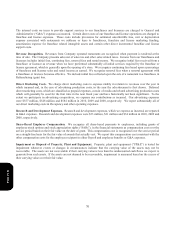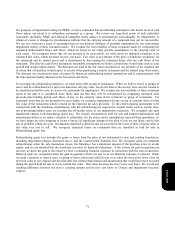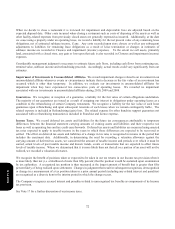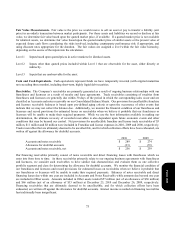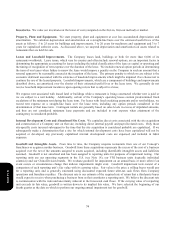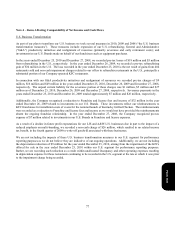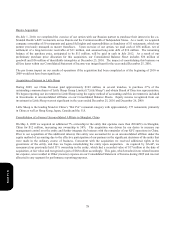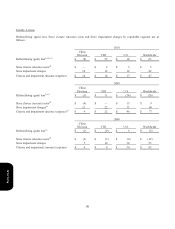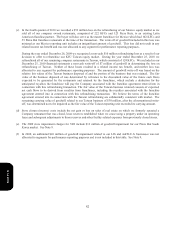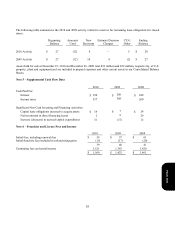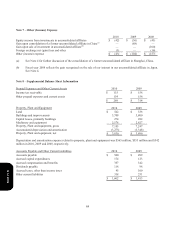Pizza Hut 2010 Annual Report Download - page 171
Download and view the complete annual report
Please find page 171 of the 2010 Pizza Hut annual report below. You can navigate through the pages in the report by either clicking on the pages listed below, or by using the keyword search tool below to find specific information within the annual report.
74
Inventories. We value our inventories at the lower of cost (computed on the first-in, first-out method) or market.
Property, Plant and Equipment. We state property, plant and equipment at cost less accumulated depreciation and
amortization. We calculate depreciation and amortization on a straight-line basis over the estimated useful lives of the
assets as follows: 5 to 25 years for buildings and improvements, 3 to 20 years for machinery and equipment and 3 to 7
years for capitalized software costs. As discussed above, we suspend depreciation and amortization on assets related to
restaurants that are held for sale.
Leases and Leasehold Improvements. The Company leases land, buildings or both for more than 6,000 of its
restaurants worldwide. Lease terms, which vary by country and often include renewal options, are an important factor in
determining the appropriate accounting for leases including the initial classification of the lease as capital or operating and
the timing of recognition of rent expense over the duration of the lease. We include renewal option periods in determining
the term of our leases when failure to renew the lease would impose a penalty on the Company in such an amount that a
renewal appears to be reasonably assured at the inception of the lease. The primary penalty to which we are subject is the
economic detriment associated with the existence of leasehold improvements which might be impaired if we choose not to
continue the use of the leased property. Leasehold improvements, which are a component of buildings and improvements
described above, are amortized over the shorter of their estimated useful lives or the lease term. We generally do not
receive leasehold improvement incentives upon opening a store that is subject to a lease.
We expense rent associated with leased land or buildings while a restaurant is being constructed whether rent is paid or
we are subject to a rent holiday. Additionally, certain of the Company's operating leases contain predetermined fixed
escalations of the minimum rent during the lease term. For leases with fixed escalating payments and/or rent holidays, we
record rent expense on a straight-line basis over the lease term, including any option periods considered in the
determination of that lease term. Contingent rentals are generally based on sales levels in excess of stipulated amounts,
and thus are not considered minimum lease payments and are included in rent expense when attainment of the
contingency is considered probable.
Internal Development Costs and Abandoned Site Costs. We capitalize direct costs associated with the site acquisition
and construction of a Company unit on that site, including direct internal payroll and payroll-related costs. Only those
site-specific costs incurred subsequent to the time that the site acquisition is considered probable are capitalized. If we
subsequently make a determination that a site for which internal development costs have been capitalized will not be
acquired or developed, any previously capitalized internal development costs are expensed and included in G&A
expenses.
Goodwill and Intangible Assets. From time to time, the Company acquires restaurants from one of our Concept’s
franchisees or acquires another business. Goodwill from these acquisitions represents the excess of the cost of a business
acquired over the net of the amounts assigned to assets acquired, including identifiable intangible assets and liabilities
assumed. Goodwill is not amortized and has been assigned to reporting units for purposes of impairment testing. Our
reporting units are our operating segments in the U.S. (see Note 18), our YRI business units (typically individual
countries) and our China Division brands. We evaluate goodwill for impairment on an annual basis or more often if an
event occurs or circumstances change that indicate impairments might exist. Goodwill impairment tests consist of a
comparison of each reporting unit’s fair value with its carrying value. Fair value is the price a willing buyer would pay
for a reporting unit, and is generally estimated using discounted expected future after-tax cash flows from Company
operations and franchise royalties. The discount rate is our estimate of the required rate of return that a third-party buyer
would expect to receive when purchasing a business from us that constitutes a reporting unit. We believe the discount rate
is commensurate with the risks and uncertainty inherent in the forecasted cash flows. If the carrying value of a reporting
unit exceeds its fair value, goodwill is written down to its implied fair value. We have selected the beginning of our
fourth quarter as the date on which to perform our ongoing annual impairment test for goodwill.
Form 10-K




